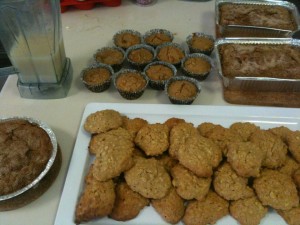The High Holidays and the Significance of Food in Judaism
Below follows my High Holydays message as published in The Voice, the Adelaide Hebrew Congregation newsletter.
I guess if I’m going to be Jewish (and a Rebbetzin, no less!), it’s a good thing I like cooking. In these weeks leading up to Rosh Hashanah and Sukkot, it seems like all I’ve been doing is cooking and baking up a storm. My fridges and freezers are full to capacity, but with 18 (yes, eighteen!) meals this holiday season, I think it’s best to work ahead a bit.
Food and eating play a central role in Judaism. You know the old joke about Jewish holidays: “They tried to kill us, we won, let’s eat!” But the reality is that eating is much more than that for us. Food is a means of connection and connection is extremely important in Judaism.
On the one hand, we use food to connect with other people. We often use food to show our love, by putting our time and effort into creating something for someone else to enjoy, even though we know it will not last (except maybe on our thighs!). Family mealtimes are an opportunity to spend time together and to focus on one another, especially on Shabbat and Yom Tov, when there are no distractions like TVs and phones. In fact, family therapists often recommend that their clients begin repairing damaged relationships by having one family dinner per week, with no interruptions. Judaism is ahead of the curve – we do this every week anyway, helping us to build strong families and relationships before there is a problem.
Food in Judaism also serves the dual purpose of connecting us to G-d. Before we eat or drink anything, we make a blessing on it. This brings us into a state of mindfulness and an attitude of gratitude that experts on happiness all agree is essential to living a joyful life. But making blessings on food does not just help us tap into a high spiritual state; focusing sincerely on our relationship with G-d actually changes physical reality. A molecular photographer once took some photos of water molecules. They were boring, straight-edged shapes. But once a blessing was made on the water, the molecules miraculously changed shape. They looked like beautiful snowflakes. Yet these were the exact same water molecules. By using them as a tool to connect with G-d, they were actually physically changed. When we ingest something that has been changed in this way, we are not only emotionally and spiritually connecting to G-d, but we are physically connecting ourselves to Him.
On Rosh Hashanah there are a variety of symbolic foods we eat. Using foods as symbols helps make their message a part of us, and has the added bonus of making their meaning more interesting and memorable. Apples and challah dipped in honey signify that we should have a sweet new year, as does honey cake. Round challahs remind us of the continuity of creation – as we finish the Torah in the holiday season, we immediately begin again. We also eat a new fruit on the second night of Rosh Hashanah, on which we make a “shecheiyanu” blessing thanking G-d for keeping us alive and bringing us to this season. Thus we are reminded to be grateful not only for every day we are alive, but also for the ability to enjoy the bounty G-d has given us. We also eat fish (or lamb), generally with the head still attached, to signify that we should be a “head” and not a “tail,” as Rosh Hashanah is the “head of the year.” Fish is also a symbol of abundance and fertility. Some people even make up their own “symbols” to include, which can be as clever and creative as you like. For example, you might make a little salad with half a raisin and some celery, so you can “half a raisin celery” (“have a raise in salary”).
On Sukkot, the food you eat is less important, but where you eat it is very important. It is the Feast of Tabernacles. While it is a great mitzvah to spend as much time in the sukkah as possible, it is much more important to be in the sukkah when you eat. It wouldn’t be much of a Feast of Tabernacles if you did your feasting outside of the tabernacle, would it? While we eat, we seek shelter in a makeshift booth, where we rely upon G-d for protection from the elements (and the bees!). Within the sukkah, we shake lulav (made up of a date palm frond, willow branch, and myrtle) and etrog (citron). The etrog is a fruit with a strong taste and smell, symbolizing Jews with Torah learning and good deeds. The date is a fruit with a good taste but no smell, representing Jews who have Torah learning but no good deeds. Myrtle smells good but has no taste, for Jews who have good deeds but no Torah knowledge. Finally, the willow has no taste and no smell, for Jews who have neither good deeds nor Torah knowledge. All four are held together because all types of Jews are important and loved by G-d. To remind themselves to strive to both learn Torah and do good deeds, many people eat etrog jelly after Sukkot is over, and it is seen as a segula (symbol) for easy birth when a pregnant woman eats it (maybe I should try this!) or for a blessing on the home when it is eaten on Tu B’Shvat.
Even less well-known holidays in Judaism come with special foods for us to eat. On the day before Yom Kippur and on Hoshanah Raba (the seventh and last day of Sukkot) (as well as on Purim) we eat kreplach (pockets of dough filled with meat or other stuffing) to symbolize two things: 1) that it is a holiday (symbolized by the meat) yet not a complete holiday (symbolized by the dough covering and hiding it) and 2) that it is a time of judgment for the Jewish people – we ask that the divine judgment (meat, which is a dead animal) be tempered by G-d’s goodness and compassion (bread, which sustains life). On Shemini Atzeret, although it is no longer Sukkot, we continue to eat in the sukkah. On Simchat Torah, we eat foods that are rolled, like the Torah is. (I know many people are thinking of deli rolls, but I am thinking of cinnamon swirls!) We also drink wine or other spirits on Simchat Torah, to help us feel the joy of Torah and so we can celebrate G-d’s goodness without inhibitions.
For us Jews, food is much more than just a gustatory and epicurean activity. It is a spiritual experience, a symbolic endeavour, and an interpersonal relationship builder. It helps us to remember who we are as Jews, where we came from, and where we are going.
So as I cook for the holidays, I’ll be adding some extra honey to my challah and kugels, and extra apple to my cakes. And most of all, I’ll be adding some extra love and care in the hopes that each and every one of us has a happy, sweet, and loving new year.
Shana tova & be’te avon,
Rebbetzin Rachel
Read more about the Jewish High Holidays:
Read more about Blowing the Shofar Before Rosh Hashanah During the Month of Elul
Read more about Rosh Hashanah Dessert Recipes
Read more about Rosh Hashanah & Sukkot Are Soon: Try Cooking Ahead!
Read more about Rosh Hashanah & Yom Kippur in Sydney, Australia
Read more about Rosh Hashanah & Yom Kippur with the Jewish community in New Caledonia
Read more about Yom Kippur: Facing Your Truth
Read more about Yom Kippur & Jonah: Talkin’ About a Revolution
Read more about Celebrating Sukkot in Newtown, Sydney, Australia
Read more about What is a Simchat Beis HaShoeva Sukkot Celebration & Are There any in Sydney, Australia?
Read more about Hoshanah Raba: We Can All Be Kings
Read More
 I feel blessed to have had the opportunity to experience the grandeur of Antarctica with over hundred fascinating people. I was part of a group of mostly Australian Entrepreneurs who gathered together to converse in, ‘how to get to the future first.’ Together, we brain stormed ideas of what the future would look like and what we collectively, and individually, could, and would do about it.
I feel blessed to have had the opportunity to experience the grandeur of Antarctica with over hundred fascinating people. I was part of a group of mostly Australian Entrepreneurs who gathered together to converse in, ‘how to get to the future first.’ Together, we brain stormed ideas of what the future would look like and what we collectively, and individually, could, and would do about it.










